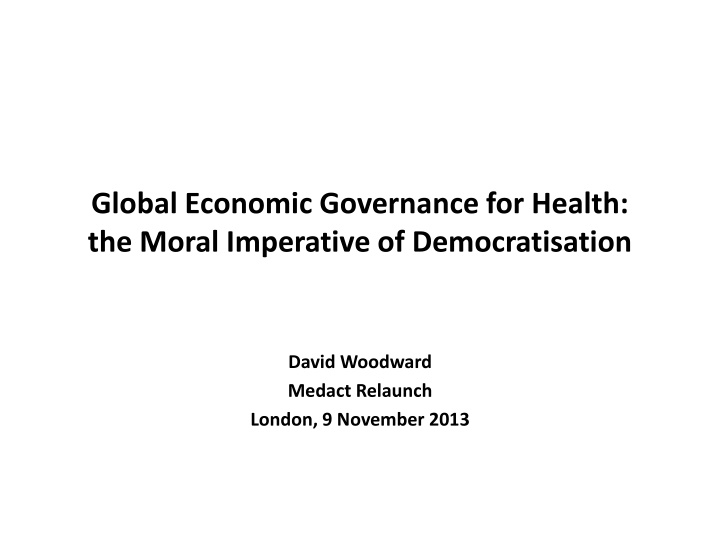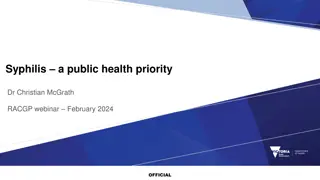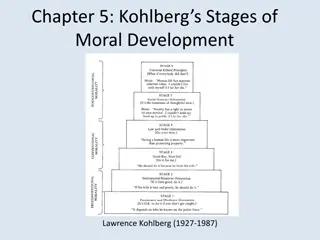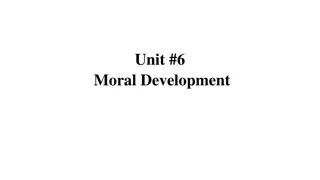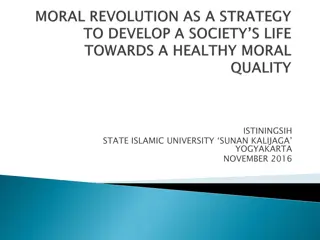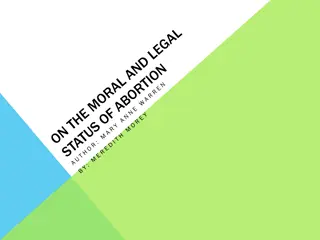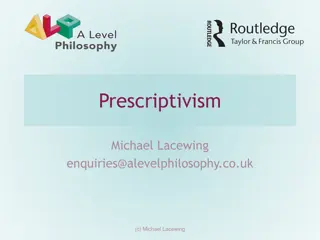Global Economic Governance for Health: The Moral Imperative of Democratisation
Distinguish between global health governance and global governance with a focus on factors affecting health systems, medical interventions, and cross-border disease transmission. Explore the role of IMF in steering the global economy for the benefit of health, emphasizing the need for democratisation in global governance to achieve health equity and fairness.
Download Presentation

Please find below an Image/Link to download the presentation.
The content on the website is provided AS IS for your information and personal use only. It may not be sold, licensed, or shared on other websites without obtaining consent from the author.If you encounter any issues during the download, it is possible that the publisher has removed the file from their server.
You are allowed to download the files provided on this website for personal or commercial use, subject to the condition that they are used lawfully. All files are the property of their respective owners.
The content on the website is provided AS IS for your information and personal use only. It may not be sold, licensed, or shared on other websites without obtaining consent from the author.
E N D
Presentation Transcript
Global Economic Governance for Health: the Moral Imperative of Democratisation David Woodward Medact Relaunch London, 9 November 2013
Distinguish between. Global health governance Global governance with respect to factors primarily affecting health Focus on health systems/sectors, medical interventions, health sector inputs, cross-border transmission of disease Centred on health-specific institutions (WHO) Global governance for health Ensuring that global governance as a whole protects and promotes health
Global Economic Governance for Health Steering the global economy in such a way as to benefit health (broadly defined) Primarily in relation to Trade (WTO, regional/bilateral agreements) Finance, debt, etc (IMF, Paris Club, BIS .) Development policy/finance (esp. World Bank, regional development banks, DAC) Overall direction/corrdination (G7/8, G20, etc) Filling gaps (TNCs, taxation, etc) Focus here on IMF
The Need for Democratisation It is only through such a system of global governance, placing fairness in health at the heart of the development agenda, and genuine equality of influence at the heart of its decision-making, that coherent attention to health equity is possible. Commission on Social Determinants of Health, 2008
in the terrible history of famines in the world, no substantial famine has ever occurred in any independent and democratic country with a relatively free press. We cannot find exceptions to this rule, no matter where we look . When things go fine and everything is routinely good, this instrumental role of democracy may not be particularly missed. It is when things get fouled up, for one reason or another, that the political incentives provided by democratic governance acquire great practical value. Amartya Sen, Democracy as a Universal Value, 1999
IMF Votes: Developed Countries cf Low-Income Countries
IMF Votes: Developed Countries cf Low-Income Countries
IMF Votes: Developed Countries cf Low-Income Countries
IMF Votes: Developed Countries cf Low-Income Countries
Indirect Mechanisms Direct effects of unequal voting power are compounded by the constituency system and Board representation asymmetry of accountability between appointed and elected Directors large constituencies and Directors workloads potential for coordination 56% of LIC governments and 2 of the 3 low-income country Directors felt they can freely criticize staff rarely or only on some issues . (IEO, 2008)
IMF Independent Evaluation Office Evaluation of IMF Governance (2008) Didn t consider the weighted voting system Found the IMF was effective in making decisions in crisis situations . .but didn t consider crisis prevention - or the appropriateness of decisions(!) When a crisis is detected, alternative mechanisms for strategy formulation, decision making, and implementation are super-imposed over the usual mechanisms. The crisis mechanisms center on a small network of senior government officials generally from the countries most closely involved (often the G-7 deputies). Pre-reform, G7 Directors alone controlled 45.1% of votes in the Executive Board now 41.2% NB IEO was headed by a former Canadian ED (a G7 member)
Manifestations Skews decision-making towards developed country and creditor interests very slow response to debt crisis (especially for low-income countries) voluntary approach to commercial debt relief Asian crisis fiasco shortcomings of adjustment HIPC/PRSP design flaws skewed priorities eg money laundering post-9/11
An Example: Compare and Contrast. Greece within two years, 70-75% cancellation available on 200bn of commercial debts Sub-Saharan Africa (crisis began 1976-82) 1988: first (limited) cancellation of debt-service payments to government creditors 1989: WB-funded debt buy-backs on commercial debts 1994: stock-of-debt cancellation on government debt 1996: multilateral debt cancellation available but built-in delay of six years+ end-2004, only 7 of 42 eligible countries had qualified
What Went Wrong? No independent mechanism for debt resolution IMF is a creditor, controlled by other creditors Financial abdication All debt relief voluntary: IMF could have enforced, but didn t Always (and clearly) too little too late degree of austerity dictated by willingness of creditors Policy cooption IMF as enforcer All financing and debt relief subject to policy conditionality Austerity politically untenable, economically damaging, socially harmful Structural adjustment driven by neoliberal ideology, economically ineffective (at best) Financial dependency used as a policy lever All reflect the interests of the developed countries
Commission on Social Determinants of Health on Structural Adjustment structural adjustment had a severe adverse impact on key social determinants of health including health care and education across most participating countries the IMF s overall policies and targets limit the resources available for health care and health personnel, and health ministries have difficulty influencing the budget-setting process it is not clear that the harsh degree and policy strait- jacket that structural adjustment imposed produced the anticipated benefits, much less whether the health and social costs were warranted
SSA: Annual Change in Life Expectancy, 1960-2010 (years) 0.6 0.5 0.4 0.3 0.2 0.1 0 1960-65 1965-70 1970-75 1975-80 1980-85 1985-90 1990-95 1995-00 2000-05 2005-10 -0.1
SSA: Annual Change in Life Expectancy, 1960-2010 (years) problems emerge, 1976ff 0.6 Substantial debt cancellation, 2004ff HIPC Initiative, 1996 Debt crisis becomes Balance of payment generalised, 1982 0.5 0.4 0.3 0.2 0.1 0 1960-65 1965-70 1970-75 1975-80 1980-85 1985-90 1990-95 1995-00 2000-05 2005-10 -0.1
SSA: Annual % Change in Under-5 Mortality, 1965-2010 3 Substantial debt cancellation, 2004ff HIPC Initiative, 1996 problems emerge, 1976ff Debt crisis becomes generalised, 1982 Balance of payment 2.5 2 1.5 1 0.5 0 1965-70 1970-75 1975-80 1980-85 1985-90 1990-95 1995-00 2000-05 2005-10
HIV/AIDS? Too much, too soon
SSA: Change in Life Expectancy, 1960- 2010 Figure 2: Sub-Saharan Africa: Annual Change in Life Expectancy at Birth, 1960-2000 (years) 0.6 0.5 0.4 0.3 0.2 0.1 0 1960-65 1965-70 1970-75 1975-80 1980-85 1985-90 1990-95 1995-00 2000-05 2005-10 -0.1
SSA Change in Life Expectancy (adjusted for HIV/AIDS) Figure 2: Sub-Saharan Africa: Annual Change in Life Expectancy at Birth, 1960-2000 (years) 0.6 0.5 0.4 adjusted for HIV (to 2000) 0.3 0.2 actual 0.1 0 1960-65 1965-70 1970-75 1975-80 1980-85 1985-90 1990-95 1995-00 2000-05 2005-10 -0.1
SSA: Annual % Change in Under-5 Mortality, 1965-2010 Figure 3: Sub-Saharan Africa: Annual Change in Under-Five Mortality, 1965-2010 (% pa) 3 2.5 2 1.5 1 0.5 0 1965-70 1970-75 1975-80 1980-85 1985-90 1990-95 1995-00 2000-05 2005-10
SSA % Change in u5MR (adjusted for HIV/AIDS) Figure 3: Sub-Saharan Africa: Annual Change in Under-Five Mortality, 1965-2010 (% pa) 3 2.5 2 adjusted for HIV (to 2000) 1.5 1 actual 0.5 0 1965-70 1970-75 1975-80 1980-85 1985-90 1990-95 1995-00 2000-05 2005-10
Extreme Poverty in SSA, 1981-2008 Figure 5: Sub-Saharan Africa: Poverty Headcount Ratio at $1.25-per-day 60 Population with household income below $1.25 per day (2008 purchaisng power HIPC Initiative, 1996 PRSP approach, 1999 55 parity) (%) 50 Debt crisis becomes generalised, 1982 45 Substantial debt cancellation, 2004ff 40 1981 1984 1987 1990 1993 1996 1999 2002 2005 2008
Average Incomes of Poor Households, SSA, 1981-2005 Figure 6: Sub-Saharan Africa: Average Incomes of Poor Households, 1981-2005 Averag household e income per person per day (2008 purchaisng power parity) 105 100 95 Next 30% of population (1981 = 100) 90 85 Poorer 50% of population 80 75 1981 1984 1987 1990 1993 1996 1999 2002 2005
HIV/AIDS? Too much, too soon HIV is not independent of debt/adjustment Poverty + responses Nutrition Health systems . Other powerful confouding factors operating in the opposite direction in the 1980s Primary health care Mass vaccination campaigns Oral reydration therapy Should have seen a major acceleration in health improvement (esp. u5MR)
The Rise of the South? Rise of BRICS and emerging markets Shifting overall North-South balance, BUT . Benefits to emerging markets relatively limited influence remains much less than population share Northern minority still dominates Doesn t benefit LICs
IMF Votes: Developed Countries cf Low-Income Countries
The Rise of the South? Rise of BRICS and emerging markets Shifting overall North-South balance, BUT . Benefits to emerging markets relatively limited influence remains much less than population share Northern minority still dominates Doesn t benefit LICs Different interests from LICs/LDCs Gap widens further as they get richer Impasse: emerging markets strong enough to block, but not to set agenda eg WTO; climate No substitute for democracy!
Conclusions The democratic deficit in global governance skews decision-making away from the interests of the poor majority As the SSA debt crisis shows, this costs (a lot of) lives The health impact could have been limited had the debt crisis been handled differently Democratising global economic governance is critical to global health.
we deem it unjust when a national economic order is coercively imposed by a powerful minority and demand that any large majority of its participants should be able to change its rules without the use of force. But few in the wealthy countries would place the same moral requirement on the global economic order most would dismiss it as ridiculous or absurd . [W]e, the affluent countries and their citizens, continue to impose a global economic order under which millions avoidably die each year from poverty-related causes. Thomas Pogge, Moral Univeralism and Global Economic Justice, 2002
